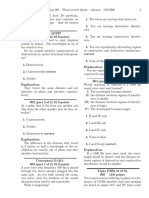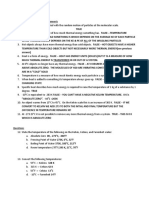Heat PDF
Heat PDF
Uploaded by
huyly34Copyright:
Available Formats
Heat PDF
Heat PDF
Uploaded by
huyly34Original Description:
Original Title
Copyright
Available Formats
Share this document
Did you find this document useful?
Is this content inappropriate?
Copyright:
Available Formats
Heat PDF
Heat PDF
Uploaded by
huyly34Copyright:
Available Formats
Ch. 11 Heat 11.
.1 Heat and Internal Energy Internal Energy U the energy associated with the microscopic kinetic (translational, vibrational, and rotational) and potential (intermolecular forces) energies of the system. Heat is a mechanism by which energy is transferred between a system and its environment because of a temperature difference between them. We will thus not talk about how hot something is, but how much energy Q is transferred to a system due to a temperature difference. Heat is thermal energy, the ability to change the T of a system in contact. Historical Unit: calorie 1 calorie is the energy necessary to raise the temperature of 1 g of water from 14.5C to 15.5C. Note: the familiar Calorie used in determining the chemical energy of food is actually 1 kcal (1000 cal). Mechanical Equivalent of Heat 1 cal ! 4.186 J Example: Problem 7 A 75.0 kg weight-watcher wishes to climb a mountain to work off the equivalent of a large piece of chocolate cake rated at 500 (food) Calories. How high must the person climb? (1 food Calorie = 103 calories). 11.2 Specific Heat Some substances require more/less than 4.186 J to raise 1 g by 1C (or 4186 J for 1 kg by 1C). We use specific heat to describe and quantify this fact. or 1 Cal ! 4186 J
specific heat
c!
Q m"T
J kg #1 !C #1
where !T = T final " Tinitial . NOTE ORDER! By definition, the specific heat for water is c = 4186 J kg-1 C-1. So the energy required to raise the temperature of a system of mass m by "T is:
Q = mc !T
Sign Convention: When T in a system increases, energy flowing into the system - Q and "T are positive When T in a system decreases, energy flowing out of the system - Q and "T are negative Application: Sea breezes Specific heat of sand is lower than that of water. Daytime heating causes breeze from sea to land as hot air rises over the sand. Exercise: Problem #2 A 50 g sample of copper is at 25C. If 1,200 J of energy is added to the copper by heat, what is its final temperature? Quick Quiz 11.1 Imagine you have 1 kg each of iron, glass, and water, and that all of the samples are at 10C. (a) Rank the samples from lowest to highest temperature after 100 J is added to each by heat. (b) Rank them from least to greatest amount of energy transferred by heat if enough energy is transferred so that each increase in temperature by 20C.
11.3 Calorimetry Suppose we put a warm object into cooler water: For any isolated system exchanging heat amongst its components: Qcold = !Qhot or Qcold + Qhot = 0 Here, Qcold = Qwater = mw cw T ! Tw
Qhot = Qsubstance x = mx cx T ! Tx mw cw so cx
w x x x
( ) (T ! T ) = !m c (T ! T ) m c (T ! T ) = m (T ! T )
w w x w x
Sign Convention: The energy transfer Qhot is negative because energy is leaving the hot substance. The minus sign in Qcold = !Qhot insures that Qcold is positive, since it is the cold object that is gaining energy. Note that Qcold + Qhot = 0 . This is may be easier to remember. Example: Problem 15 An aluminum cup contains 225 g of water and a 40-g copper stirrer, all at 27C. A 400 g sample of silver at an initial temperature of 87C is placed in the water. The stirrer is used to stir the mixture gently until it reaches its final equilibrium temperature of 32C. Calculate the mass of the aluminum cup. Example: Problem 18 A combination of 0.250 kg of water at 20.0C, 0.400 kg of aluminum at 26.0C , and 0.100 kg of copper that is at 100C is mixed in an insulated container and allowed to come to thermal equilibrium. Neglect any energy transfer to or from the container and determine the final temperature of the mixture.
10.4 Latent Heat & Phase Change Phase Changes: vapor#liquid liquid#solid vapor#solid solid1#solid2 boiling/condensing melting/freezing sublimation
Energy associates with phase change Q = mL , where L is the latent heat of the substance for that particular phase change. Sign Convention: Q = +mL adding energy
Q = !mL
( example : melting ice cube) removing energy ( example : freezing water )
Heat of fusion melting/freezing Heat of vaporization boiling/condensing Heat of sublimation
Remember, in solving problems: 1. consistent units 2. Q = mc!T only if no phase change
Q = mL fusion (solid#liquid); Q = mLvapor (liquid#vapor)
3. remember signs, and that !T = T final " Tinitial
Example: Taking ice at T=-30.0C to vapor at T=120.0C (at constant pressure)
Part A. Warming ice, T changes Q = mcice !T Part B. Melting ice, T constant Q = mL fusion Part C. Warming water, T changes Q = mcwater !T Part D. Vaporizing water, T constant Q = mLvapor Part E. Warming vapor. T changes Q = mcsteam !T Exercise: Problem 23 What mass of steam that is initially at 120C is needed to warm 350 g of water and its 300-g aluminum container from 20C to 50C?
11.5 Thermal Conduction Conduction net transfer of energy due to vibrational motions of atoms, molecules, and (in the case of electrical conductors) mobile electrons without a net flow of the material.
!=
Q = k ! "t thermal
conductivity
$T # Tcolder ' "T = kA & hotter ) "x % "xhotter #cooler (
!=
A Thotter # Tcolder Q A Thotter # Tcolder = = "t Li k Rnet $ !i i $ Ri
i
Can you think of another example where the flow goes inversely with the resistance?
Example: Problem #39 A copper rod and an aluminum rod of equal diameter are joined end to end in good thermal contact. The temperature of the free end of the copper rod is held constant at 100C, and that of the far end of the aluminum rod is held at 0C. If the copper rod is 0.15m long, what must be the length of the aluminum rod so that the temperature at the junction is 50C?
11.6 Convection Convection heat transfer by macroscopic movement of matter. Natural Convection lower density creates buoyancy - heated roadways, campfires, etc. Forced Convection using fans, pumps, etc. some heating systems
Mathematically, convection is very difficult to deal with far beyond the scope of this course! (Notice that the textbook has NO problems for this section!)
11.7 Radiation All objects with T > 0 K radiate electromagnetic radiation at a rate of: ! = " AeT 4 Watts Stefan's Law
" = 5.699x10#8 W m#2 K #4 A = surface area e = emissivity An object in radiative contact with surroundings at temperature T0 will absorb an amount of energy !abs = " AeT04 So the net gain/loss of energy by radiation is !net = " Ae T 4 # T04
(Actually its a little more complicated than this, because here we have assumed that e is the same for the absorption and emission i.e. that the absorption and emission occur over the same wavelength ranges.) Thermogram of a human.
Example: Problem 11.44 Calculate the temperature at which a tungsten filament that has an emissivity of 0.25 and a surface area of 2.5x10-5 m2 will radiate energy at a rate of 25 W in a room where the temperature is 22C. 11.8 Resisting Energy Transfer
Thermos bottles (more appropriately called Dewar flasks) help thermally isolate their contents thermally from the rest of the world.
The Hubble Space Telescope reduces T fluctuations from entering & exiting the Earths shadow using a blanket of highly reflective insulation.
11.9 Global Warming & Greenhouse Gases The low e in the infrared due to various gases raises the T of the earth above what it would be in the absence of an atmosphere. This greenhouse effect is a misnomer, as real greenhouses get most of their T increase from inhibiting convective energy transport.
CO2, one of the major greenhouse gases, is on the rise. A doubling of CO2 could lead to a global increase in T of 2C (according to one estimate), which could have a significant impact on the climate of the Earth.
In addition to CO2, CH4, N2O, and SO2 contribute. 2/3 of the greenhouse effect is due to H2O!! This was not included in climate models until about 10 years ago.
There is some evidence that the Earth is warming slightly in the past century (although not all parts of the atmosphere seem to be doing the same thing, so it is complex). Changes in solar irradiation may also be contributing to this trend.
You might also like
- Quest Waves 1 KeyDocument7 pagesQuest Waves 1 KeyCarlos OrtizNo ratings yet
- BB101 Engineering Science Chapter 6 Temperature and HeatDocument7 pagesBB101 Engineering Science Chapter 6 Temperature and HeatAh Tiang100% (4)
- 143Document15 pages143Fikret BazNo ratings yet
- Advanced GRE Math QuestionsDocument22 pagesAdvanced GRE Math Questionsmulasravanialekhya84% (19)
- (Topics in Organometallic Chemistry Vol.2) Shu Kobayashi - Lanthanides - Chemistry and Use in Organic Synthesis - Springer (1999)Document303 pages(Topics in Organometallic Chemistry Vol.2) Shu Kobayashi - Lanthanides - Chemistry and Use in Organic Synthesis - Springer (1999)Hakeem AfridiNo ratings yet
- Lecture 13-4Document35 pagesLecture 13-4Mapalo faith ChamaNo ratings yet
- F.3 Heat NoteDocument12 pagesF.3 Heat Noteskywalker_handsomeNo ratings yet
- Thermal PhysicsDocument66 pagesThermal PhysicsguiNo ratings yet
- 01 Temperature & HeatDocument17 pages01 Temperature & HeatMarc Alamo100% (1)
- 17 Thermal-Heat and Kinetics GasDocument34 pages17 Thermal-Heat and Kinetics Gaskirana wahyuniNo ratings yet
- Heat Lecture NotesDocument62 pagesHeat Lecture NotesAS HUMBLE PIANONo ratings yet
- Dr. Nurul Nadia Adnan Abridged By: DR. AHMAD HASSANDocument27 pagesDr. Nurul Nadia Adnan Abridged By: DR. AHMAD HASSANThalagawali RajagopalNo ratings yet
- KalorDocument53 pagesKalorsuprihadi estiNo ratings yet
- Lecture Notes 9 - Thermal Energy, Temperature, and HeatDocument7 pagesLecture Notes 9 - Thermal Energy, Temperature, and HeatJezManuel04No ratings yet
- Thermal Contact and Thermal Equilibrium. Two Objects Are inDocument40 pagesThermal Contact and Thermal Equilibrium. Two Objects Are in11 AniketNo ratings yet
- Temperature and HeatDocument48 pagesTemperature and Heatalexzandrei.rara937No ratings yet
- Questions On ConceptsDocument3 pagesQuestions On ConceptsNicole LeinesNo ratings yet
- 02 - Heat Transfer MechanismDocument21 pages02 - Heat Transfer MechanismAndreana Amor GulayNo ratings yet
- Ch17 Young Freedman2Document14 pagesCh17 Young Freedman2Andrew MerrillNo ratings yet
- Temperature and HeatDocument35 pagesTemperature and HeatDonna Mae ValleNo ratings yet
- Module 2 - Heat and ThermodynamicsDocument12 pagesModule 2 - Heat and ThermodynamicsANGELO NINO ALVARADONo ratings yet
- Thermal Energy LawsDocument24 pagesThermal Energy LawsPengintaiNo ratings yet
- Thermal Physics IB Physics: Topic 3 & Option CDocument55 pagesThermal Physics IB Physics: Topic 3 & Option CMoiz Dhanerawala100% (1)
- Practice Quiz Answers-1 PDFDocument3 pagesPractice Quiz Answers-1 PDFJoan Conje Bonagua100% (1)
- CLS Aipmt 16 17 XI Phy Study Package 3 SET 1 Chapter 11Document16 pagesCLS Aipmt 16 17 XI Phy Study Package 3 SET 1 Chapter 11Raja Gopal0% (2)
- Chapter 11Document32 pagesChapter 11bidinNo ratings yet
- Thermal Physics Physics 1X: Miles Padgett M.padgett@physics - Gla.ac - UkDocument68 pagesThermal Physics Physics 1X: Miles Padgett M.padgett@physics - Gla.ac - UkHany ElGezawy100% (1)
- Calorimetry ThermodynamicsDocument15 pagesCalorimetry Thermodynamicssanits591No ratings yet
- HeatDocument63 pagesHeatShinjiNo ratings yet
- A2 53a ThermalenergyDocument39 pagesA2 53a ThermalenergyHany ElGezawyNo ratings yet
- Definition of Heat CapacityDocument48 pagesDefinition of Heat CapacityPunitha NagappanNo ratings yet
- ME311 Assignment 1 ConductionDocument4 pagesME311 Assignment 1 ConductionPradumn DixitNo ratings yet
- Chapter 6 Heat and TemperatureDocument9 pagesChapter 6 Heat and TemperatureF1040 AleeyaNo ratings yet
- Thermal PhysicsDocument68 pagesThermal PhysicsAbdul HalimNo ratings yet
- Basic Concepts of Thermo With Examples With Solutions Part 2Document20 pagesBasic Concepts of Thermo With Examples With Solutions Part 2arunyogNo ratings yet
- Chapter 17 - Work, Heat, and The First Law of ThermodynamicsDocument42 pagesChapter 17 - Work, Heat, and The First Law of Thermodynamicsn4alpacaNo ratings yet
- Introduction PDFDocument156 pagesIntroduction PDFIsyana MelzNo ratings yet
- MODULE 2 - (Heat Thermodynamics) - Lecture OnlyDocument9 pagesMODULE 2 - (Heat Thermodynamics) - Lecture OnlyMa.Victoria LonodNo ratings yet
- Clean Energy Lecture 2Document28 pagesClean Energy Lecture 2Tze Long GanNo ratings yet
- Thermometry: T/s T/KDocument9 pagesThermometry: T/s T/KJing Yu VoonNo ratings yet
- ThermodynamicsDocument41 pagesThermodynamicsmy nameNo ratings yet
- Cryobiology Heat Transfer ProblemsDocument24 pagesCryobiology Heat Transfer ProblemsSumanta KarNo ratings yet
- Homework Thermo2Document13 pagesHomework Thermo2Mia L. AyuningtyasNo ratings yet
- Review Notes in Physics 2-ECEDocument12 pagesReview Notes in Physics 2-ECEAnonymous cuVSFiNo ratings yet
- SPM Phy Quantity of Heat IDocument13 pagesSPM Phy Quantity of Heat ICHINEMEREM EZEHNo ratings yet
- Bansal CLasses Physics Study Material For IIT JEEDocument521 pagesBansal CLasses Physics Study Material For IIT JEEmuno93% (14)
- 2 All About Heat (Students - Copy)Document54 pages2 All About Heat (Students - Copy)Crystal HuffNo ratings yet
- Measures The of An Object.: of Thermal Energy Between Objects With Different TemperaturesDocument29 pagesMeasures The of An Object.: of Thermal Energy Between Objects With Different TemperatureswilhelmclimbNo ratings yet
- Conceptual Integrated Science 2nd Edition Hewitt Solutions Manual 1Document6 pagesConceptual Integrated Science 2nd Edition Hewitt Solutions Manual 1james100% (49)
- Chapter 9 - Heat ThermodynamicsDocument47 pagesChapter 9 - Heat ThermodynamicsMuhammad Aminnur Hasmin B. HasminNo ratings yet
- Thermodynamics AllDocument141 pagesThermodynamics AllSidharth AryaNo ratings yet
- QuestionsDocument11 pagesQuestionsR MathewNo ratings yet
- Chapter 18:temperature, Heat and The First Law of Thermodynamics (Fundamental of Physics, 10 Edition)Document16 pagesChapter 18:temperature, Heat and The First Law of Thermodynamics (Fundamental of Physics, 10 Edition)BerlinNo ratings yet
- Lecture 1Document20 pagesLecture 1Sadika Afrin SnigdhaNo ratings yet
- A Modern Course in Statistical PhysicsFrom EverandA Modern Course in Statistical PhysicsRating: 3.5 out of 5 stars3.5/5 (2)
- Thermodynamic analysis of geothermal heat pumps for civil air-conditioningFrom EverandThermodynamic analysis of geothermal heat pumps for civil air-conditioningRating: 5 out of 5 stars5/5 (2)
- Practice Makes Perfect in Chemistry: The Physical Behavior of MatterFrom EverandPractice Makes Perfect in Chemistry: The Physical Behavior of MatterRating: 5 out of 5 stars5/5 (1)
- How it Works: Dealing in simple language with steam, electricity, light, heat, sound, hydraulics, optics, etc., and with their applications to apparatus in common useFrom EverandHow it Works: Dealing in simple language with steam, electricity, light, heat, sound, hydraulics, optics, etc., and with their applications to apparatus in common useNo ratings yet
- Gre Wordlist PDFDocument3 pagesGre Wordlist PDFhuyly34No ratings yet
- GRE 2010 by The Princeton Review Excerpt PDFDocument46 pagesGRE 2010 by The Princeton Review Excerpt PDFhuyly34No ratings yet
- Gre Wordlist PDFDocument3 pagesGre Wordlist PDFhuyly34No ratings yet
- 2015 - Mcat PDFDocument158 pages2015 - Mcat PDFhuyly34No ratings yet
- NewGRE PDFDocument1 pageNewGRE PDFhuyly3450% (2)
- NBWL For Web Part3Document56 pagesNBWL For Web Part3gunalprasadgNo ratings yet
- Physics GRE SolutionsDocument338 pagesPhysics GRE SolutionsDavid Latchman100% (2)
- File 3) GRE 2008 Database PDFDocument265 pagesFile 3) GRE 2008 Database PDFhuyly340% (1)
- File 2) GRE Quant (Ignore First 85 Pages, Which Are in File 1) PDFDocument333 pagesFile 2) GRE Quant (Ignore First 85 Pages, Which Are in File 1) PDFhuyly34100% (1)
- 2015 - Mcat PDFDocument158 pages2015 - Mcat PDFhuyly34No ratings yet
- Crushing The GREDocument8 pagesCrushing The GREapi-38386330% (1)
- File 1) GRE 2009 From - Nov - 18 PDFDocument84 pagesFile 1) GRE 2009 From - Nov - 18 PDFhuyly34No ratings yet
- Admin Assistant Label JD-111014Document2 pagesAdmin Assistant Label JD-111014huyly34No ratings yet
- Warehouse Asst - Storage and Picking - JD-111112Document2 pagesWarehouse Asst - Storage and Picking - JD-111112huyly34No ratings yet
- Driver JD-111010Document2 pagesDriver JD-111010huyly340% (1)
- Driver's Assistant JD-111010Document2 pagesDriver's Assistant JD-111010huyly34No ratings yet
- Cleaner JD 111010Document2 pagesCleaner JD 111010huyly34No ratings yet
- Delivery Man JD-111010Document2 pagesDelivery Man JD-111010huyly34No ratings yet
- Quotation Cold Room An NAM Group - 17 Aug 2010Document12 pagesQuotation Cold Room An NAM Group - 17 Aug 2010huyly34No ratings yet
- Admin Assistant Dispatch JD-111410Document2 pagesAdmin Assistant Dispatch JD-111410huyly34No ratings yet
- Competency ListDocument2 pagesCompetency Listhuyly34No ratings yet
- MMH Equipment Glossary: Industrial Truck Equipment Powered, Non-PoweredDocument4 pagesMMH Equipment Glossary: Industrial Truck Equipment Powered, Non-Poweredhuyly34No ratings yet
- 26 49 2 PB With Cover PageDocument13 pages26 49 2 PB With Cover PageDianNo ratings yet
- Open Price Close PriceDocument3 pagesOpen Price Close Priceanita mahajanNo ratings yet
- Abrites Diagnostics For Mercedes OnlineDocument14 pagesAbrites Diagnostics For Mercedes OnlineGarvin Alberto Sandrea ParisNo ratings yet
- Final Notes NCM 100Document4 pagesFinal Notes NCM 100Jasmin CubillasNo ratings yet
- Group Oral PresentationDocument2 pagesGroup Oral PresentationRodrick RamosNo ratings yet
- Spine HR Suite E-BrochureDocument20 pagesSpine HR Suite E-BrochureMahesh GuptaNo ratings yet
- Poems To MemorizeDocument5 pagesPoems To MemorizeJULIO MANUEL OLIVARESNo ratings yet
- Drawing Printout - How To Draw Chibi GirlsDocument5 pagesDrawing Printout - How To Draw Chibi Girlssteve johnNo ratings yet
- Final ExamA1-2019-1Document4 pagesFinal ExamA1-2019-1trinh.lenukieuNo ratings yet
- Sea of Souls Volume III (Extra Content)Document28 pagesSea of Souls Volume III (Extra Content)Vitor Hugo Sant Ana Vieira (NoName)No ratings yet
- Ethionamide and Ethambutol Antitubercular Agents Medicinal ChemistryDocument4 pagesEthionamide and Ethambutol Antitubercular Agents Medicinal ChemistryROCK PNo ratings yet
- Pengkajian LukaDocument26 pagesPengkajian LukaPebruariNo ratings yet
- Silhouette 500 PDFDocument2 pagesSilhouette 500 PDFCarlos Padilla0% (1)
- DOC697 Rev G YASARAGIL Aneurysm Clip System BrochureDocument48 pagesDOC697 Rev G YASARAGIL Aneurysm Clip System BrochureJosé Javier CalderonNo ratings yet
- Naskah PublikasiDocument13 pagesNaskah Publikasiashry09No ratings yet
- 4 BoardCompanion BiologyDocument58 pages4 BoardCompanion BiologyEntirety 4uNo ratings yet
- Science10 Quarter4 Week3-BiomoleculesDocument2 pagesScience10 Quarter4 Week3-BiomoleculesMargareth LandichoNo ratings yet
- RGPV Course File Cs-801 Soft ComputingDocument13 pagesRGPV Course File Cs-801 Soft ComputingJoin2FlyNo ratings yet
- Technical Standard - Ts-108: For Distribution Equipment and Transformer RoomsDocument32 pagesTechnical Standard - Ts-108: For Distribution Equipment and Transformer RoomsJoel KionisalaNo ratings yet
- T9-Internet For Teaching and LearningDocument25 pagesT9-Internet For Teaching and LearningJoshua LsqNo ratings yet
- Car StarterDocument3 pagesCar Starterapi-509827005No ratings yet
- Piper BetleDocument6 pagesPiper BetleNyayu_Fitriani100% (1)
- Red Hat Enterprise Linux 9 Securing Networks en UsDocument94 pagesRed Hat Enterprise Linux 9 Securing Networks en Usbent vaderNo ratings yet
- Burt Berkson, MD, PHD - Curing-Stage-4-Cancer-And-Terminal-Liver-DiseaseDocument14 pagesBurt Berkson, MD, PHD - Curing-Stage-4-Cancer-And-Terminal-Liver-Diseaseguy777No ratings yet
- Multiple IntelligencesDocument2 pagesMultiple IntelligencesNtsako BaloyiNo ratings yet
- PT Corona Dwi DayaDocument8 pagesPT Corona Dwi Dayaandi rafiansyahNo ratings yet
- SAILMA Grades Steel Plates & SheetsDocument2 pagesSAILMA Grades Steel Plates & SheetsElumalai SrinivasanNo ratings yet
- Quick ReferenceDocument32 pagesQuick ReferenceManoj RautNo ratings yet














































































































